Understanding the ÖSD Certificate A1: What You Required to Know
In an increasingly interconnected world, the capability to interact in several languages has ended up being a valuable property. For people seeking to demonstrate their proficiency in the German language, the Austrian Language Diploma (ÖSD) offers a structured and acknowledged certification program. Among the numerous levels of this accreditation, the ÖSD Certificate A1 works as the entry point for newbies. This post explores the qualifications of the ÖSD A1 certification, its function, structure, and significance, in addition to answers to some regularly asked concerns.
What is the ÖSD Certificate A1?
The ÖSD Certificate A1 is a foundational language proficiency test developed to measure a prospect's capability to communicate in standard German. It falls under the Common European Framework of Reference for Languages (CEFR), which supplies a standardized scale for evaluating language efficiency. The A1 level is categorized as the starting phase, where people are expected to understand and utilize familiar daily expressions and fundamental phrases aimed at pleasing practical requirements.
Significance of the ÖSD Certificate A1
The ÖSD Certificate A1 has several crucial implications for individuals looking to improve their language skills and enhance their individual and professional potential customers. Here are a few reasons this certification is substantial:
Structure of Language Learning: The A1 level serves as a stepping stone for learners who wish to advance to higher levels of efficiency in German.
Worldwide Recognition: The ÖSD certificates are extensively recognized in Austria and Germany, increasing employability in German-speaking nations and reinforcing visa applications.
Evaluation of Basic Skills: The exam evaluates vital abilities in reading, composing, listening, and speaking, giving learners a clear understanding of their linguistic ability.
Structured Learning Path: Obtaining the A1 certificate sets the groundwork for learners to systematically construct their language skills.
Structure of the ÖSD Certificate A1
The ÖSD Certificate A1 comprises four primary elements that assess different language skills:
Listening Comprehension (Hörverstehen):.
Candidates listen to tape-recorded dialogues and brief texts. They should answer concerns that examine their understanding and ability to extract essential info.
Reading Comprehension (Leseverstehen):.
This section consists of reading short texts, discussions, or ads, followed by questions that examine comprehension and analysis.
Composed Expression (Schreiben):.
In this part, students need to produce brief written texts, such as completing forms or writing basic messages, demonstrating their ability to interact in composing.
Oral Expression (Sprechen):.
Prospects participate in a discussion with an examiner, which can consist of answering questions about individual subjects, explaining familiar things, or discussing everyday circumstances.
Preparing for the ÖSD Certificate A1.
Success in the ÖSD A1 examination requires sufficient preparation. Here are some pointers for efficient study:.
Study Materials: Utilize ÖSD-approved textbooks, online courses, and practice tests specifically developed for the A1 level.
Expand Vocabulary: Focus on vocabulary related to everyday subjects such as household, jobs, foods, and pastimes.
Practice Listening: Engage with German-speaking media, including podcasts, movies, and songs, to enhance listening skills.
Conversation Practice: Join language exchange programs or groups to practice consulting with native speakers or fellow learners.
Mock Tests: Regularly total practice tests to acquaint oneself with the exam format and time restraints.
Advantages of Earning the ÖSD Certificate A1.
Achieving the ÖSD A1 certificate not just confirms one's language skills but also unlocks different opportunities for individual and expert development. Here are some benefits of holding this accreditation:.
Improved Job Opportunities: Many employers in German-speaking countries worth language certification, especially at the A1 level, as it shows commitment to communication.
Admission to Language Courses: Some language schools require evidence of A1 proficiency as a requirement for advancing to greater courses.
Confidence in Communication: The certificate boosts self-confidence in basic interaction, a vital ability for living or operating in a German-speaking environment.
Cultural Immersion: Learning the language invites deeper cultural understanding, allowing people to link more meaningfully with German-speaking neighborhoods.
FAQ Section.
1. Who is eligible to take the ÖSD Certificate A1 exam?
The exam is open to people over the age of 16 who want to prove their fundamental knowledge of German. No previous credentials are necessary.
2. What is the passing score for the ÖSD A1 exam?
Candidates should achieve at least 60% of the overall indicate pass the assessment.
3. Where can I take the ÖSD A1 exam?
The ÖSD A1 exam is used in numerous examination centers around the world, specifically in Austria and Germany. It is suggested to inspect the ÖSD site for the closest place.
4. For how long is ösd b1 ?
The ÖSD Certificate A1 does not expire, and learners can provide it anytime to demonstrate their proficiency.
5. Can I prepare for the exam on my own?
Yes, numerous candidates successfully prepare independently using research study materials, however attending classes or language workshops can assist in quicker discovering.
Conclusion.

The ÖSD Certificate A1 functions as a vital tool for those embarking on their journey to discover the German language. With its structured approach and acknowledgment in German-speaking areas, this certification leads the way for improved interaction abilities, enhanced work prospects, and a much deeper understanding of German culture. By investing time in preparation and practice, learners can achieve this fundamental turning point and set the stage for ongoing language development.
